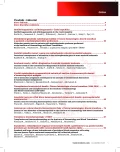-
Medical journals
- Career
Transfusion and immunohematology at the Institute of Haematology and Blood Transfusion
Authors: M. Písačka; H. T. Bolcková; J. Králová; E. Matějková; E. Miarková
Authors‘ workplace: Ústav hematologie a krevní transfuze, Praha
Published in: Transfuze Hematol. dnes,23, 2017, No. Supplementum1, p. 87-93.
Category:
Overview
Transfusion therapy at the Institute of Haematology and Blood Transfusion continues to evolve in line with trends of modern transfusion medicine, aiming to maximize safety and personalization of transfusion products. Immunohematology links the transfusion section to the clinical departments. The Reference Laboratory cooperates with a wide range of departments in the Czech Republic and abroad, investigating diagnostically complicated cases and discrepant findings. It participates in the production of samples and supervises the national proficiency testing scheme (SEKK). It introduces new molecular biology techniques and participates in their development, thus extending and improving the accuracy of immunohematology diagnostics. Numerous new blood group alleles have been described by the Reference Laboratory when assessing atypical findings. The Department of Immunohematology also investigates anti-platelet and anti-HLA antibodies and selects appropriate donors for patients with Feto-maternal alloimmune thrombocytopenia (FMAIT) and platelet transfusion refractoriness and provides suitable transfusion products in cooperation with the Apheresis Department. The routine and research activities of the Transfusiology Division are important not only for the treatment of UHKT patients, but also for the whole Czech health system. They also have impact abroad.
KEY WORDS:
transfusion – imunohematology – Institute of Haematology and Blood Transfusion (UHKT) – NRL (National reference laboratory) for imunohematology – new diagnostic methods in imunohematology – new blood group alleles – HPA (human platelet antigen) – HLA (human leukocyte antigen) – FMAIT (Feto-maternal alloimmune thrombocytopenia) – refractoriness
Sources
1. Moulds JM. Future of molecular testing for red blood cell antigens. Clin Lab Med 2010;30(2):419–429.
2. Anstee DJ. Red cell genotyping and the future of pretransfusion testing. Blood 2009;114(2):248–256.
3. Landsteiner K. Uber agglutinationserscheinungen normalen menschlichen blutes. Wien Klin Wochenschr 1901;14 : 1132–1134.
4. Janský J. Hematologické studie u psychotiků. Sborník klinický 1907;8 : 85–139.
5. Písačka M. Krevní skupiny – historické aspekty, současné poznatky a „česká stopa“ v imunohematologii. Slavnostní Janského přednáška. Transfuze Hematol dnes 2009;15(Suppl 3):20–25.
6. Písačka M, Kořínková P, Matějková E, Bolcková HT. Imunohematologie – historie, současný stav poznání a role ÚHKT. Vnitř Lék 2012;58(Suppl. 2):103–114.
7. Písačka M, Králová M, Králová J, et al. Bw phenotype caused by a new missense mutation in exon 7 – a family study in Northern Moravia. Vox Sanguinis 2016;111 (Suppl.1):226.
8. Písačka M, Králová M, Králová J, et al. Weak B phenotype caused by a novel para-Bombay mutation. Vox Sanguinis 2017;112(Supplement S1):520.
9. Písačka M, Marinov I, Králová M, et al. FY*A silencing by the GATA-motif variant FY*A(-69C) in a Caucasian family. Transfusion 2016;55 : 2616–2619.
10. Písačka M, Marinov I, Králová M, et al. FY*A(-69C): A novel FY*A expression silencing allele occuring in a Caucasian family. Vox Sanguinis 2015;109 (Suppl.1):298.
11. Storry JR, Pisacka M, Pejchalova A, Hult AK, Olsson ML. Heterozygosity for consensus FUT1 associated with a new ABH phenotype challenging current dogma: H-negative group A or B. Vox Sanguinis 2010;99 : 379–380.
Labels
Haematology Internal medicine Clinical oncology
Article was published inTransfusion and Haematology Today

2017 Issue Supplementum1-
All articles in this issue
- Genetic tests for selecting haematopoietic stem cell donors and post-transplant monitoring
- Centre for rare disorders of haematopoiesis at the Institute of Haematology and Blood Transfusion
- Transfusion and immunohematology at the Institute of Haematology and Blood Transfusion
- Standard and large volume leukapheresis of peripheral blood progenitor cells using the new Spectra Optia continuous mononuclear cell collection protocol
- Dysfibrinogenaemia and afibrinogenaemia in the Czech Republic
- Molecular genetic tests in patients with myelodysplastic syndrome performed at the Institute of Haematology and Blood Transfusion
- Functional consequences of mutations in the nucleophosmin gene in acute myeloid leukaemia
- Current trends in the treatment and diagnostics of chronic myeloid leukaemia
- Use of molecular cytogenetic techniques in the analysis of chromosomal aberrations in haematological malignancies
- Haematopoietic cell transplantation at the Institute of Haematology and Blood Transfusion (1986–2016)
- Transfusion and Haematology Today
- Journal archive
- Current issue
- Online only
- About the journal
Most read in this issue- Dysfibrinogenaemia and afibrinogenaemia in the Czech Republic
- Centre for rare disorders of haematopoiesis at the Institute of Haematology and Blood Transfusion
- Transfusion and immunohematology at the Institute of Haematology and Blood Transfusion
- Functional consequences of mutations in the nucleophosmin gene in acute myeloid leukaemia
Login#ADS_BOTTOM_SCRIPTS#Forgotten passwordEnter the email address that you registered with. We will send you instructions on how to set a new password.
- Career

